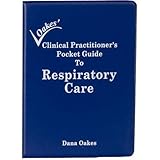This is a guest post by respiratory therapy and EMT-B student Jared Scott. If you want to guest post on this blog, check out the guidelines here.
As an EMT student, I have come to realize that we are taught very simple life-saving techniques: ABC’s. Airway, breathing, and circulation.Two of these (airway and breathing) fall directly within the same body system– the respiratory system– and as my time in Respiratory Therapy schooling has shown, EMS providers are not taught nearly enough to fully understand the respiratory system and its more complex disease processes and concepts that medics and EMTs run calls on all the time.
Because of this, I would like to use my knowledge as an RT student and share with my fellow EMS providers some excellent respiratory reading material.
Respiratory Disease: a case study approach to patient care
 An important part of an EMT or Paramedic’s assessment is evaluating the patient’s respiratory condition. For some patients, respiratory diseases are often a part of their past medical history. Wilkins’ Respiratory Disease gives an in-depth explanation of a number of respiratory diseases that are only briefly covered in EMS education programs, such as Chronic Bronchitis, Emphysema, Interstitial Lung Disease, Cystic Fibrosis, Asthma, and Bronchiectasis.
An important part of an EMT or Paramedic’s assessment is evaluating the patient’s respiratory condition. For some patients, respiratory diseases are often a part of their past medical history. Wilkins’ Respiratory Disease gives an in-depth explanation of a number of respiratory diseases that are only briefly covered in EMS education programs, such as Chronic Bronchitis, Emphysema, Interstitial Lung Disease, Cystic Fibrosis, Asthma, and Bronchiectasis.
Each chapter of the book can be read in roughly an hour or less, and provides in-depth information on the etiology, epidemiology, and treatment of a particular disease, as well as actual case studies, which include lab values, pertinent patient history, assessment, and recommended treatment for the disease(s).
 Clinical Applications of Mechanical Ventilation by Chang, David. (2005). Clinical application Delmar Pub.
Clinical Applications of Mechanical Ventilation by Chang, David. (2005). Clinical application Delmar Pub.
Many of my paramedic, CCP, and MICT colleagues often transport patients on the ventilator. Quite a few of them have come to me with questions about mechanical ventilation: modes, settings, principles, and so on. I realize that Paramedic school skims the surface regarding Mechanical Ventilation, so this book is for anyone who has ever wanted to know more about it.
Chang’s Mechanical Ventilation provides both a concise and easy-to-read approach regarding respiratory physiology and the practical application of the simplest ventilatory modes (VC/AC, PC/AC), to the more advanced modes and concepts (BiLevel, APRV, intrinsic PEEP).
The chapters are relatively short, but an excellent resource for anyone who takes care of a mechanically ventilated patient. One of my favorite things about this text is that it offers visual examples, and key points are highlighted in the margins.

Clinical practitioner’s pocket guide to respiratory care. Health Educator Publications, Inc.
Textbooks are excellent, but as we all know, they don’t often come in handy in the back of a rig, or even in the hospital setting when you’re knee-deep in patients and don’t have the time to pull out a large book. If an EMT or paramedic were to come to me and ask what is the one resource I would recommend for the care of a respiratory patient, the Clinical Practitioner’s Pocket Guide to Respiratory Care would be it.
I can’t even begin to count the number of times I have used this reference, or how many times I will in the future. It summarizes and highlights virtually everything to do with the respiratory patient, including respiratory assessment, cardiovascular dynamics, pulmonary dynamics, cardiovascular and respiratory equations, respiratory pharmacology, diseases (including a description of each disease, recommended treatment, and much more), as well as CPR and clinical practice guidelines/steps for almost every respiratory procedure.
Another thing I have come to learn that many paramedics and paramedic students struggle with is ABG interpretation and acid-base principles. The best part about this reference, in my opinion, is a detailed chapter on nothing but ABGs, including a handy little chart to help you interpret a blood gas.
These are but a few of the excellent resources I have found to be helpful for both Respiratory Therapists and EMS providers alike. Remember– as a provider in any health care field, it is important to continually educate yourself for the benefit of your patients.
Coming soon: Helpful respiratory links and web resources.
Jared Scott is an RT and EMT-B student in Texas. In his free time, he authors the blog Surviving RT School and is co-host on the new podcast Generation Medicine. He can be found on Twitter (@myrtlife) or reached via email at jared (at) genmedshow (dot) com.
//